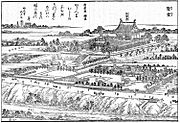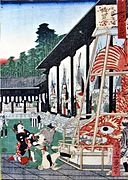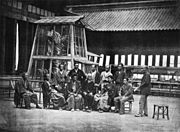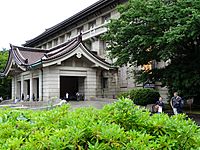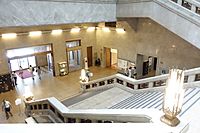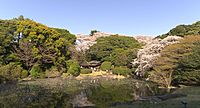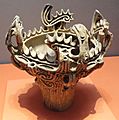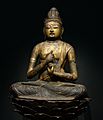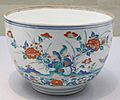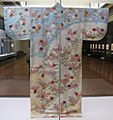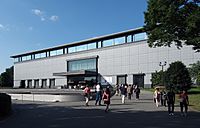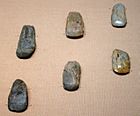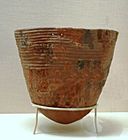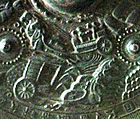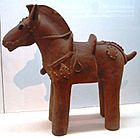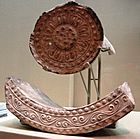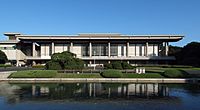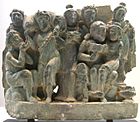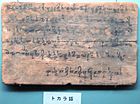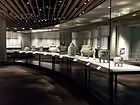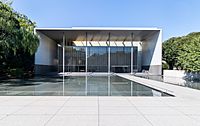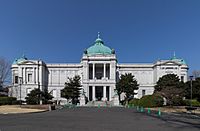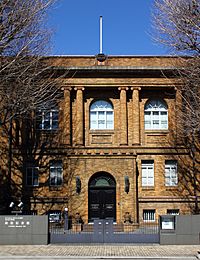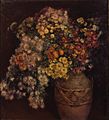Tokyo National Museum facts for kids
| 東京国立博物館 | |
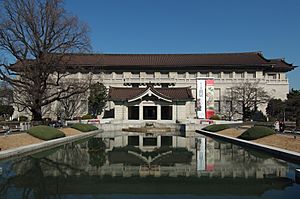
The Honkan (Main Gallery)
|
|
| Established | 1872 (Yushima Seido Exhibition) 1873 (permanent display) 1882 (present location) 2007 (present administration) |
|---|---|
| Location | Ueno, Taitō, Tokyo, Japan |
| Type | Art museum |
| Collection size | 110,000 |
| Visitors | 2,180,000 (2017) |
| Public transit access |
|
The Tokyo National Museum (TNM) is a famous art museum located in Ueno Park in Tokyo, Japan. It is the oldest and largest art museum in Japan. The museum collects, protects, and shows a huge collection of art and cultural items. It focuses on ancient and medieval Japanese art and art from other parts of Asia, especially along the Silk Road. You can also find a large collection of Greco-Buddhist art here.
As of April 2023, the museum had about 120,000 important cultural items. This includes 89 National Treasures and 649 Important Cultural Properties. The museum also displays about 3,000 items at a time, changing them every few weeks. Besides showing art, the museum also does research and holds educational events.
The museum has several buildings, each with different exhibits. These include the Honkan (Japanese Gallery), the Heiseikan and Hyokeikan (for special shows), the Toyokan (Asian Gallery), and the Gallery of Horyuji Treasures. There are also restaurants, shops, and a beautiful garden to explore.
Contents
Museum Names Over Time
The Tokyo National Museum has had several names since it first opened. When it started in 1872, it was called the "Museum of the Ministry of Education." Later, it was known simply as "the Museum."
In 1888, it became the Imperial Museum because the imperial family took ownership. To be more specific, it was renamed the Tokyo Imperial Household Museum in 1900. After World War II, in 1947, it became the "National Museum." Finally, in 2001, it received its current name, the "Tokyo National Museum." Sometimes, people still call it the "Ueno Museum" because of its location.
A Look Back: Museum History
The First Exhibition (1872)
The Tokyo National Museum is Japan's oldest national museum. Its story began with the Yushima Seido Exhibition in 1872. This was a public show of imperial artworks and scientific items. It was held by the Ministry of Education from March 10 to April 30, 1872.
This exhibition helped Japan prepare for the 1873 Vienna World's Fair. Japan wanted to show its products to the world and boost its exports. For the fair, two samples of important products from each Japanese province were collected. One went to Vienna, and the other was kept for a new museum in Japan. The 1872 exhibition was very popular, with about 150,000 visitors.
-
The male shachi of the Nagoya Castle at the exhibition. Shosai's ukiyo-e print.
Moving to Ueno Park
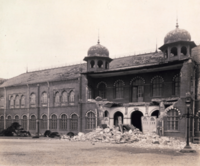
Ueno Park was created in 1873. The museum's first director, Hisanari Machida, thought the large park would be perfect for a museum. The museum officially moved to Ueno Park in 1881. The original main building, called the Honkan, was finished in time for the Second National Industrial Exhibition.
The museum and a new Ueno Zoo officially opened on March 20, 1882, with Emperor Meiji attending the ceremony. In 1888, the imperial family took over the museum. They focused its work on cultural and scientific topics.
Sadly, the original Honkan building was badly damaged in the 1923 Great Kantō earthquake in 1923. Exhibits had to be moved to another building, the Hyokeikan, which was not damaged. After the earthquake, a new design for the Honkan was chosen in 1931. The new building, which you can see today, opened in 1938.
The museum was closed in 1945 during the end of World War II. In 2022, the Tokyo National Museum celebrated its 150th anniversary. For the first time ever, all 89 of its National Treasures were shown together in one special exhibition.
Museum Buildings and Galleries
Honkan: Japanese Art Gallery
The Honkan is the main building and houses the museum's collection of Japanese art. This art spans from ancient times to the late 1800s. It has two floors and a basement, covering a large area. The building is designed to be safe from fires and earthquakes.
The current Honkan was designed by Jin Watanabe. It has a classical base with a Japanese-style roof. It was completed in 1938 and is now considered an Important Cultural Property.
The rooms in the Honkan are set up to guide visitors through Japanese art history. You can see everything from ancient pottery to samurai armor and beautiful paintings.
| Second Floor | First Floor | ||
|---|---|---|---|
| Room | Title | Room | Title |
| 1 | The Dawn of Japanese Art and Rise of Buddhism | 11 | Japanese Sculpture |
| Jomon, Yayoi, Kofun | |||
| 2 | National Treasure Gallery | 12 | Lacquerware |
| Various periods | |||
| 3 | Buddhist Art, Courtly Art, and Zen & Ink Painting | 13 | Metalwork and Ceramics |
| Heian, Muromachi | |||
| 4 | The Art of Tea Ceremony | 14 | Thematic Exhibition |
| Various periods | |||
| 5 | Attire of the Military Elite | 15 | Records of History |
| Heian, Edo | |||
| 6 | Attire of the Military Elite | 16 | Ainu and Ryukyu |
| Heian, Edo | |||
| 7 | Folding Screens and Sliding Door Paintings | 17 | Conservation and Restoration |
| Various periods | |||
| 8 | The Arts of Daily Life and Developments in Painting and Calligraphy | 18 | Modern Art |
| Azuchi-Momoyama, Edo | |||
| 9 | Noh and Kabuki | 19 | Education Space |
| Various periods | |||
| 10 | Ukiyo-e and Fashion in the Edo Period | 20 | Giftshop |
| Edo | |||
-
A Middle Jōmon vessel (3000–2000 BCE)
-
Kokin Wakashū, Heian period, 10th century
-
Twelve Heavenly Generals, Kamakura period, 13th century
-
Tachi Okanehira, Heian period, 12th century
-
Ō-yoroi, Edo period, 16th century
-
Noh mask from the Konparu school, Edo period, 18th century
Heiseikan: Special Exhibitions and Archaeology
The Heiseikan building is where the museum holds its special, temporary exhibitions. It has four large galleries on its second floor. On the first floor, you'll find the Japanese Archaeology Gallery. This area also has a lounge, a café, an auditorium, and rooms for lectures.
The Heiseikan opened in 1999. Its name comes from the Heisei Era, which was the time of Emperor Akihito's rule (1989-2019). The building was built to celebrate the wedding of Crown Prince Naruhito (now Emperor Naruhito) in 1993.
The Japanese Archaeology Gallery shows how archaeologists use science to date old objects. It displays many finds from Japanese sites. You can see some of the world's oldest pottery from the Jomon period here.
-
Incipient Jōmon pottery (radiocarbon dated to 12500 ±350 BP)
-
A Final Jōmon statuette (1000–400 BCE)
-
Horse chariots during the Kofun period. Detail of bronze mirror (5th–6th century). Eta-Funayama Tumulus, Kumamoto.
-
The Buddha, Asuka period, 7th century
-
Temple tiles from Nara, 7th century
Toyokan: Asian Art Gallery
The Toyokan is also known as the Asian Gallery. It shows the museum's collections of art from China, Korea, India, Southeast Asia, and Central Asian art. It also has some Egyptian objects. There's a theater in the basement and a dining area next to it.
The Toyokan was designed by Yoshirō Taniguchi and opened in 1968. It was updated in the early 2010s and reopened in 2013. It has three main stories, but with its unique design of mezzanines and stairs, it feels like six floors of exhibits.
| Floor | Room | Name |
|---|---|---|
| B1 | 11 | Khmer Sculpture |
| 12 | Gilt Bronze Statues from Southeast Asia Archaeology of India and Southeast Asia Southeast Asian Ceramics |
|
| 13 | Asian Textiles Indian Miniature Paintings Ethnic Cultures of Asia |
|
| 1 | 1 | Chinese Buddhist Sculpture |
| 2 | 2 | Oasis2 Education Space |
| 3 | Sculptures from India and Gandhara Art of the Western Regions Artifacts from West Asia and Egypt |
|
| 3 | 4 | The Advent of Chinese Civilization |
| 5 | Chinese Bronzes Burials in China Chinese Ceramics Chinese Textiles |
|
| 6 | Oasis6 Education Space | |
| 4 | 7 | Stone Relief Carvings of China |
| 8 | Chinese Painting Chinese Calligraphy Chinese Literati |
|
| 5 | 9 | Chinese Lacquerware Decorative Art of the Qing Dynasty |
| 10 | Polished Stone Tools and Metal Tools of Korea The Rises and Falls of Kings in Korea Korean Ceramics Buddhist Art of Korea Art of the Joseon Dynasty |
-
Seated Buddha, Gandhara, 1st–2nd century CE
-
Northern Wei Buddha Maitreya, 443
-
Wooden plate with inscriptions in Tocharian. Kucha, China, 5th–8th century.
Gallery of Horyuji Treasures
The Gallery of Horyuji Treasures is a two-story building. It holds a special collection of items from the Horyu Temple in Nara. There are 319 items in this collection. The temple gave these treasures to the Imperial Household in 1878. They were then placed at the National Museum for safekeeping.
This building was designed by Yoshio Taniguchi and opened in 1999. It has a Reference Room where visitors can use a digital archive to see the entire collection. Explanations are available in several languages. There is also a restaurant on the first floor.
| Floor | Room | Name |
|---|---|---|
| 1 | 1 | Banner for the Kanjo Ceremony |
| 2 | Gilt Bronze Buddhist Statues, Halos, Repoussé Buddhist Images | |
| 3 | Gigaku Masks | |
| 2 | 4 | Wooden and Lacquer Works |
| 5 | Metalwork | |
| 6 | Painting, Calligraphy, and Textiles |
Hyokeikan: A Historic Building
The Hyokeikan building opened in 1909. It was built to celebrate the wedding of Crown Prince Yoshihito (who later became Emperor Taisho) in 1900. This building is a great example of Western-style architecture from the late Meiji Era. Because of its historical importance, it was named an Important Cultural Property in 1978. The Hyokeikan is usually closed to the public. It only opens for special exhibitions.
Kuroda Memorial Hall: Western-Style Art
The Kuroda Memorial Hall displays art by Kuroda Seiki. He was an important Japanese artist who painted in a Western style (called yōga). His collection includes 126 oil paintings and 170 drawings. The hall is located northwest of the main museum area. It has free admission and separate opening hours.
The hall was built in 1928 using money from Kuroda's will. He wanted to use his fortune to help promote art. In 2007, the Tokyo National Museum took over its management. The hall was renovated and reopened in 2015. It is now open whenever the main museum is.
The exhibition on the second floor has four rooms. These include the Kuroda Memorial Room and the Collection Highlights Gallery. There is also a cafe on both the first and second floors.
Research and Information Center
The Research and Information Center is a place for studying. It holds books, magazines, images, and other documents. These materials are about history, archaeology, and art from Japan, Asia, and the Middle East.
The center opened in 1984. The public area has two reading rooms and an exhibition space. You can access it for free through the museum's west gate, even without paying for museum admission.
Museum Funding
The Tokyo National Museum faces challenges with its budget. Japan's government spends less on culture compared to many other developed countries. For example, in 2017, Japan's cultural budget was much smaller than France's or South Korea's.
The Tokyo National Museum's yearly budget is about ¥2 billion. This is much less than what big museums like the Louvre or the British Museum receive. By 2023, the museum was finding it hard to pay for repairs to its cultural items and cover rising electricity costs. The museum has asked the government for more money, but the request has not been approved. The museum's director often talks about these money problems in the news.
Getting There
 JU JK JY JJ G H Ueno Station (with JR East and Tokyo Metro)
JU JK JY JJ G H Ueno Station (with JR East and Tokyo Metro)- JK JY Uguisudani Station (with JR East)
- KS Keisei Ueno Station (with Keisei Electric Railway)
- C Nezu Station (with Tokyo Metro)
More to Explore
- Lists of National Treasures and Horyuji Treasures at the Tokyo National Museum
- Kuromon ("Black Gate"), one of two surviving feudal main gates in Tokyo
- Kyoto, Kyushu, and Nara National Museums
- Japanese art
- Greco-Buddhist art
- Silk Road
- Machida Hisanari
- List of largest art museums
- List of National Treasures of Japan
See also
 In Spanish: Museo Nacional de Tokio para niños
In Spanish: Museo Nacional de Tokio para niños


